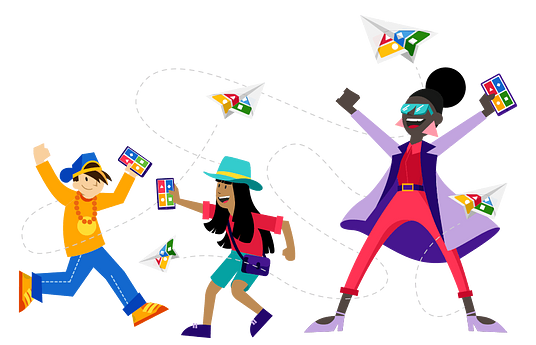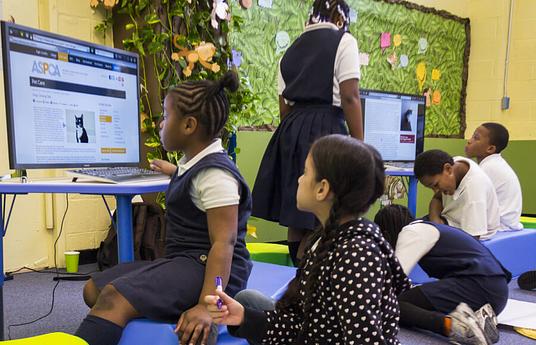When it comes to school, some of the debates are as old and familiar as education itself. But one relatively new conundrum is causing confusion in the classroom – should students be using cell phones in class?
For French president Emmanuel Macron, it’s a definite ‘non!’. Come September, France, where 93% of 12-17 year-olds own mobile phones, is implementing a blanket ban on cell phones in schools, ramping up the current ban on phones in classrooms. Parents and teachers are divided on the issue, with some arguing that kids should be allowed to live in the modern world, while others are fearful of the dangers that smartphones present to wellbeing and learning.
It’s true that smartphones can be a tool for unscrupulous students to cheat and they could prove too distracting for some young people. Adults understandably worry about unhealthy amounts of screen time and the threats that the internet, a space not designed with children in mind, can pose to young people’s safety and emotional wellbeing. But that’s only half of the picture. Used in meaningful, safe, and helpful ways smartphones and other devices can be a ground-breaking and game-changing tool for learning.
The fourth industrial revolution (or ‘Industry 4.0’, as it’s sometimes known) will see physical and digital spheres merging, with advanced technologies like AI and the Internet of Things impacting all areas of daily life, including our careers. It’s tough to think of a job that doesn’t include some kind of use of digital technology. Our recent research report revealed that 83% of students want to learn career-related skills, which in this age has to include the proficient use of technology and seamless integration of devices as tools for research, communication, project management and so on. So what good are we doing young people by restricting (reasonable) technology use in the classroom?
In many innovative learning environments, devices are an indispensable tool. If you visit a Self-Organized Learning Environment, you’ll see groups of learners huddled around a device, eagerly researching answers to ‘big questions’ and directing their own learning in the process. In flipped classrooms, you might find kids engrossed in online lectures before diving into a hands-on project. Around the world, you’ll find educators bringing learning to life with the help of AR, VR, and international collaborative learning projects with the help of the internet. Smartphones, tablets and other internet-enabled devices are opening up learning opportunities like never before.
Educators are turning to gamified learning strategies to motivate, engage, and inspire their students. And while traditionally teachers may have had to spend hours gamifying their lesson plan, with the help of tools like Kahoot, teachers can create games and quizzes in mere minutes. Kahoot, an innovative tool designed to engage students with learning material in a social, game-show style way, has won the hearts of students and teachers worldwide.
The free platform is used in half of US classrooms and has over 50 million active users around the world, and it’s not hard to see why. If you see a classroom using Kahoot, it’s a far cry from the ‘smartphone zombies’ some might fear when they think of phones in class. These classrooms are dynamic, social, engaged, motivated.
Gamified learning exemplifies the shift away from reading textbooks in the classroom to active knowledge-building through any internet enabled device. But gaming isn’t the online use of smartphones and tablets. Digital storytelling is springing up in innovative classrooms as a way of turning learning material into compelling, emotional and memorable stories. Students can use tablets or phones to work together to produce background research, storylines and rich multimedia documentation, which can increase both cognitive and emotional engagement with the topic of study in a way that textbooks just can’t.
On a school trip, you might see students capturing images on their smartphone, but it won’t be for Snapchat. Instead, these young people are using the digital platform ThingLink to build a web of images that make it possible for students to virtually travel across distance and time to learn anything they want.
Learners can take their geography lessons to new heights by documenting plants and animals for a virtual nature path, creating an immersive culture tour for another school, or documenting a field trip to a historic landmark, giving depth and real-world meaning to the facts and figures they learn.
And when those experience aren’t available to them? Teachers can use technologies like VR to bring those experiences to the classroom. Finnish innovation Lyfta invites children to become global explorers through immersive experiences and engaging human stories. Using tablets or VR headsets, students use 360 interactive stories, short documentary films, VR, AR and rich media articles to learn about the experiences of others around the world – a vital 21st-century learning experience in itself and something that 49% of students want to see improved in their education.
Being wary of change and aware of potential threats is no bad thing, but we have to be realistic about the tech-reliant workforce that these students will enter. Rather than pushing devices out of the classroom, why not take the opportunity to teach children how to strike a balance, to use devices responsibly and effectively. By embracing the use of tech in a way that is helpful and meaningful, even if it’s a little out of the comfort zone, we can revolutionize the classroom experience and provide learning opportunities that we could only dream of just a generation ago




